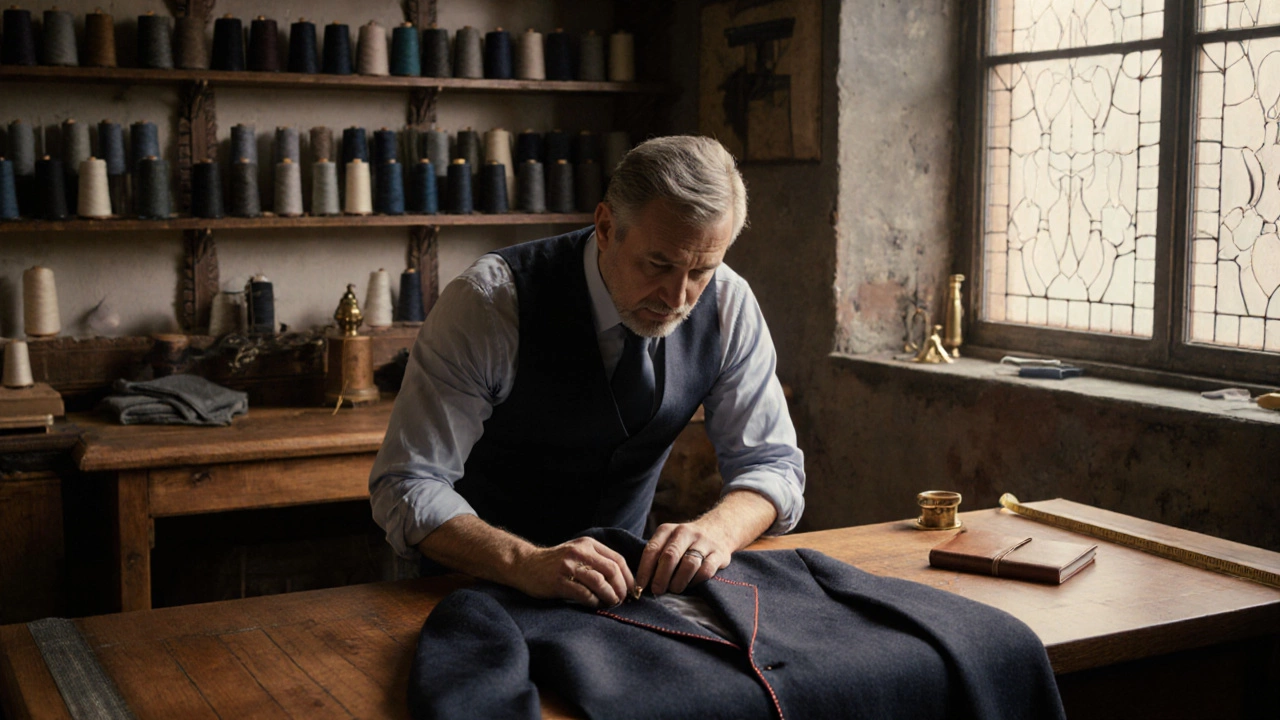Pick Stitching Cost Calculator
Estimate Your Pick Stitching Cost
Calculate the approximate cost of adding pick stitching to your custom suit based on Irish cities, suit parts, and thread color.
Estimated Cost
Select your options to see the estimated cost.
When you walk into a tailoring shop in Ireland, the first thing you’ll hear is a question about the little details that make a suit truly yours. One of those details is pick stitching - the fine line of decorative stitches that runs along the edges of a suit’s lapel, pocket trim or canvas. If you’ve ever wondered whether that extra stitch is worth the cost, you’re not alone. Irish professionals, expats working in Dublin’s tech scene, and anyone dressing up for a wedding in Galway all face the same decision. Below we break down what pick stitching actually is, when it adds value, how Irish tailors price it, and how to decide if it fits your style and budget.
What Is Pick Stitching?
Pick stitching is a decorative line of hand‑stitched threads that follows the shape of a garment’s seam or edge. The stitches are usually finer than regular topstitching and are placed on the visible side of the fabric, creating a subtle visual cue that the piece was made by hand. In a classic two‑piece suit, you’ll most often see it on the lapel edge, pocket flaps, and sometimes the outer seam of the canvas inner.
Because the stitches are hand‑sewn, they showcase a tailor’s skill and the suit’s construction quality. The thread color can match the fabric for an invisible finish or contrast for a bolder statement - think white pick stitches on a navy wool suit, a popular look at Dublin’s Grafton Street fashion week.
When Does Pick Stitching Make Sense?
Not every suit needs pick stitching. Here are three scenarios where the detail shines:
- Formal events with a traditional dress code. A wedding in County Kerry or a gala at the National Concert Hall feels more refined when the suit’s lapels have a clean, hand‑stitched line.
- Personal branding for business professionals. Executives in Dublin’s Silicon Docks often use subtle pick stitching to signal bespoke quality without being flashy.
- Showcasing tailoring craft. If you’re commissioning a custom suit from a renowned Irish tailor, the pick stitch is a hallmark of the bespoke process.
On the flip side, casual shirts‑day outfits, weekend trips to the Cliffs of Moher, or suits meant for rugged use (e.g., hunting parties in Donegal) typically don’t benefit from the extra detail.
Cost vs. Value in the Irish Market
Irish tailors charge per stitch or per hour. A typical pick‑stitched lapel can add €30‑€80 to a suit price, depending on the thread quality and the tailor’s reputation. Here’s a quick snapshot of pricing in three major cities:
| City | Tailor | Lapels (per side) | Pocket Flap |
|---|---|---|---|
| Dublin | Henry’s Tailors | €45 | €20 |
| Cork | O’Connor Bespoke | €38 | €18 |
| Galway | McCarthy Clothiers | €40 | €19 |
While the numbers look modest, remember that a hand‑stitched line also adds durability. The fine thread resists fraying better than a printed line, which can be a boon if you commute on the Luas or need a suit that looks sharp after a rainy Dublin morning.

Style Considerations for Irish Events
Irish climate and cultural cues affect how you style a pick‑stitched suit:
- Colour palette: Earthy greys, deep navy, and muted greens work well with the typical Irish backdrop of stone walls and mossy countryside. Matching the thread to a slightly lighter shade of the suit fabric can create a “shadow” effect that catches the eye without clashing with rainy skies.
- Fabric choice: Wool blends (e.g., 70% pure Irish wool, 30% polyester) are common for year‑round wear. Pick stitching on a heavier tweed can be lost, so reserve it for smoother worsted wool or flannel fabrics.
- Event type: For a St. Patrick’s Day corporate dinner, a subtle tone‑on‑tone pick stitch adds elegance. For a traditional Irish music session, a contrasting white stitch on a charcoal suit may feel out of place.
In short, think of the surroundings and the event’s formality before adding the detail.
How to Choose a Tailor in Ireland
Bespoke tailoring in Ireland is a blend of heritage and modern service. When looking for someone who can do pick stitching, keep these pointers in mind:
- Reputation for handwork. Look for tailors who advertise “hand‑stitched lapels” or showcase photos of the process on their website. Dublin’s Brown Thomas often features local tailors like J. McEvoy Tailors in its “Made in Ireland” section.
- Sample inspection. Ask to see a finished suit with pick stitching. The thread should be even, with no loose ends. A good sign is a tiny loop of thread on the inside, indicating the stitch was sewn from the inside out.
- Transparent pricing. The best tailors give a clear breakdown - per lapel, per pocket, and any extra for contrasting thread.
- Local convenience. If you live in Cork, choose a shop within a short drive to avoid multiple trips for fittings. Many Irish tailors now offer a “mobile fitting” service, bringing the suit to your home in the suburbs of Dublin or Limerick.

DIY vs. Professional Pick Stitching
Some hobbyists attempt pick stitching at home using a needle and a high‑quality thread. While it’s doable, the result rarely matches a master tailor’s precision. Here’s a quick comparison:
| Aspect | DIY | Professional |
|---|---|---|
| Time | 2‑4 hours per suit | 30‑60 minutes per lapel |
| Consistency | Variable | Uniform, even tension |
| Cost | €10‑€15 for thread | €30‑€80 per lapel |
| Durability | Prone to breakage | Resistant to wear |
If you’re after a one‑off look for a costume party, DIY can be fun. For everyday business wear or a wedding suit, invest in a professional finish - the extra cost pays off in how the suit ages.
Quick Checklist Before You Commit
- Is the suit for a formal or business setting?
- Do you have a fabric that shows fine stitching (smooth wool, flannel)?
- Have you compared tailors in your city - prices, portfolios, reviews?
- Will the extra cost fit within your budget for a custom suit?
- Do you prefer subtle matching thread or a contrasting pop of colour?
If the answer is yes to most of these, pick stitching is likely a worthwhile upgrade for your Irish suit.
Frequently Asked Questions
What is the difference between pick stitching and topstitching?
Pick stitching uses finer, usually single‑thread stitches placed on the visible side of the fabric for a decorative effect. Topstitching is thicker, often double‑thread, and is used for structural reinforcement as well as design.
Can I choose any thread colour for pick stitching?
Yes, most Irish tailors let you pick a thread that matches, slightly contrasts, or boldly stands out from the suit fabric. Common choices are ivory, navy, and burgundy on darker suits.
How much extra does pick stitching add to a bespoke suit in Dublin?
Typically €30‑€45 per lapel and €15‑€20 per pocket. Some high‑end shops may charge a flat €80‑€100 for the full suit if you want matching thread on all visible seams.
Is pick stitching visible on darker fabrics?
On very dark fabrics, matching thread creates a subtle “shadow” line that only becomes obvious up close. If you want more visibility, choose a light or contrasting thread.
Do I need special care for a pick‑stitched suit?
Treat it like any fine suit: dry‑clean only, avoid harsh chemicals, and store on a wide‑shouldered hanger. The stitches themselves don’t require extra care, but a rough wash can pull the thread.
Whether you’re a Dublin tech exec heading to a client pitch, a student attending a graduation ceremony in Limerick, or a tourist wanting a polished look for a night out on Grafton Street, the decision to add pick stitching hinges on style, budget, and the expertise you can find locally. With the right tailor and a clear understanding of the cost‑benefit, a pick‑stitched suit can become a timeless piece in your Irish wardrobe.
